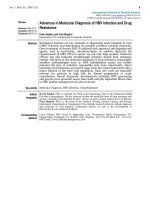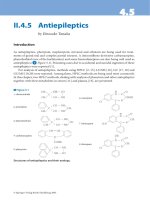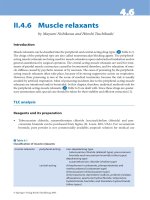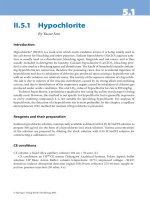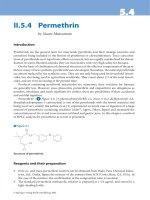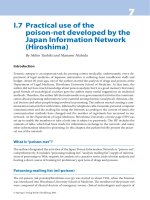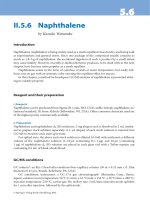Lipid profile variations in a group of healthy elderly and centenarians pptx
Bạn đang xem bản rút gọn của tài liệu. Xem và tải ngay bản đầy đủ của tài liệu tại đây (31.72 KB, 5 trang )
er in some ethnic groups than in industrial-
ized nations
2
.
The former have a particular social struc-
ture, diet and physical activity and their adap-
tation to western life style would markedly
increase vascular risk
3
. Given that the possi-
bilities of intervention on the genetic factors
linked to aging are extremely limited, we fo-
cused our attention on phenotypic-biohu-
moral conditions capable of influencing
longevity in relation to the modifications pre-
sent in the different age classes. We evaluat-
ed the lipid balance in an elderly institution-
alized population divided into age classes in
order to assess aging induced changes.
Patients and Methods
We evaluated the lipid profile in an elderly
institutionalized population of 80 subjects (20
males and 60 females divided into four age
classes) from the town of Catania (Table I).
Health state of our study series was evaluated
by anamnesis, clinical examination and com-
mon laboratory methods. We excluded from
our study the patients presenting the follow-
ing symptoms: arterial hypertension, cardio-
vascular diseases, acute cerebral strokes, dia-
betes, endocrine or metabolic disorders.
Subjects on pharmacological treatment due
to insomnia, anxiety, articular pain and gas-
trointestinal diseases, were excluded from the
study, because of influences of various drugs
on lipidic profile.
The causes of institutionalization were
firstly linked to the family:
• 35 subjects were widows;
• 15 subjects were neglected by relatives;
European Review for Medical and Pharmacological Sciences
75
Abstract. – Epidemiological and clinical
studies have clearly shown a close relationship
between plasma cholesterol concentrations and
vascular risk. We focused our attention on the
phenotypic-biohumoral conditions capable of in-
fluencing longevity in relation to different age
classes. We evaluated the lipid profile in an el-
derly institutionalized population of 80 subjects
(20 males and 60 females divided into age class-
es) in the town of Catania.
Our results revealed a statistically significant
reduction in total cholesterol, triglycerides and
LDL-cholesterol concentrations as well as Apoli-
poprotein B100/ Apolipoprotein A1, total choles-
terol/HDL-cholesterol and LDL-cholesterol/HDL-
cholesterol ratios, and a significant increase in
HDL-cholesterol, Apolipoprotein A1, Apolipopro-
tein B100 and Lipoprotein (a) values. This
changes are progressiv with age.
We believe that low total cholesterol, LDL-
cholesterol and triglyceride concentrations, ele-
vated HDL-cholesterol values, and low ratios
protect subjects from ischemic and thrombotic
events, thus favouring longevity. These changes
are most evident and statistically significant in
the most advanced decades of life, especially in
centenarians, and may depend on diverse deter-
minants, such as body composition, environ-
mental factors, physical activity, diet and drugs.
Key Words:
Aging, Lipoproteins, Lp(a), Centenarians.
Introduction
Epidemiological and clinical studies have
clearly shown a close relationship between
plasma cholesterol concentrations and vascu-
lar risk
1
. Although it is impossible to conduct
controlled studies aimed at detecting the ge-
netic factors of longevity, the incidence of
vascular disease is much lower and onsets lat-
Lipid profile variations in a group of healthy
elderly and centenarians
M. MALAGUARNERA, I. GIUGNO, P. RUELLO, M. RIZZO, M.P. PANEBIANCO,
G. PISTONE, F.B. TOMASELLO
Department of Internal Medicine and Geriatrics,– University of Catania (Italy)
1998; 2: 75-79
Number of patients Age-range (Years) Mean-age (Years) BMI
20 70-79 76.7 ± 3.16 * 24.38 ± 2.13
28 80-89 83.39 ± 1.81 22.97 ± 1.39
12 90-99 92.25 ± 2.22 22.95 ± 1.55
20 Centenarians 102.95 ± 2.58 * 22.69 ± 1.38
76
• 15 subjects without sons or unmarried;
• 15 subjects sustained by the Town Hall.
Group A was composed of 20 subjects be-
tween 70 and 79 years (mean age 76.7 ± 3.16
years); group B of 28 subjects between 80
and 89 years (mean age 83.39 ± 1.81 years);
group C of 12 subjects between 90 and 99
years (mean age 92.25 ± 2.22 years); group D
of 20 centenarians (mean age 102.95 ± 2.58
years) (Table I).
Diet
All subjects enrolled in the study followed
a balanced diet for two months (1600 Kcal)
composed of low fat (max 20% total calo-
ries) with less than 300 mg/day intake of
cholesterol. The diet was made up of 55%
carbohydrates, 20% proteins and 25% fats
(9% saturated fatty acids, 9% monosaturat-
ed fats, 7% polyunsaturated fats). We evalu-
ated: body weight, height and Body Mass
Index (BMI).
Activity Daily Living (ADL) and
Instrumental Activity Daily Living (IADL)
We administered to the patients ADL
4
and
IADL
5
Lawton’s tests in order to evaluate
their self-sufficiency levels and physical activ-
ity. With this aim, we assigned to ADL test a
score for each of the six items (with a mini-
mum of 1 and a maximum of 3 points) with a
score ranged between 6-18.
The patients totally self-sufficient showed
a score ranged between 6-8; the patients with
partial self-sufficiency showed a score ranged
9-13; patients with non self-sufficiency show-
ed a score >13.
We assigned to IADL text a score ranged
1-5 for each of the 8 items. This test allowed
M. Malaguarnera, I. Giugno, P. Ruello, M. Rizzo, M.P. Panebianco, G. Pistone, F.B. Tomasello
us to verify the ability to move and to comu-
nicate to the society (score between 6-31).
Active subjects showed a score ranged 8-15
points.
Partially active subjects showed a score
ranged 16-20 points. Unactive subjects showed
a score ranged >20 points.
Fasting blood samples were withdrawn from
all subjects to determine the following parame-
ters: total cholesterol, HDL-cholesterol (HDL-
c) and triglycerides using colorimetric methods
(Boehringer Mannheim, Germany, reactive);
LDL-cholesterol (LDL-c) calculated using
Friedewald’s formula; total cholesterol/HDL-c,
LDL-c/HDL-c and Apo B/Apo A-I ratios as
indices of cardiovascular risk; Lipoprotein(a)
[Lp(a)] using ELISA method, reader 2550 and
Immunozym reactive (Immuno, Austria,
Vienna). A-I and B100 apolipoproteins (Apo
A-I and Apo B100) were determined using the
nephelometric method with reactive supplied
by the Istitut Behring SpA (Germany) and a
Nephelometer Analyzer Behring. Sera were
stored at -80° C within 3 hours.
Statistical analysis was performed using
Student’s t test for paired data.
Results
The results of the study are reported in the
Tables II and III. There was a statistically sig-
nificant reduction in total cholesterol be-
tween groups A and C (p< 0.025), groups B
and C (p< 0.025), groups A and D (p< 0.001)
and groups B and D (p< 0.001). HDL-c in-
creased progressively with age, the difference
being statistically significant between groups
A and D (p< 0.01), B and D (p< 0.025) and C
and D (p< 0.001). LDL-c decreased signifi-
cantly between groups A and C (p< 0.01),
groups B and C (p< 0.025), groups A and D
(p< 0.001) and B and D (p< 0.001).
* p=0.002
Table I. Characteristics of patients.
Apo A-I concentrations increased and pre-
sented a statistically significant difference be-
tween groups B and D (p< 0.05) and A and D
(p< 0.05), while Apo A-I concentration de-
creased between groups B and C (p< 0.01);
the decrement in Apo B100 was statistically
significant between groups A and B (p<
0.005), A and C (p< 0.001) and A and D (p<
0.01). There was a statistically significant re-
duction in Apo B100/Apo A-I ratio between
groups A and B (p< 0.025), groups A and C
(p< 0.001), groups A and D (p< 0.001), B and
D (p< 0.05) and C and D (p< 0.025).
77
Lipid profile variations in a group of healthy elderly and centenarians
There was a significant reduction in total
cholesterol/HDL-c ratio between groups A
and D (p< 0.001), B and D (p< 0.001), C and
D (p<0.01); the LDL-c/HDL-c ratio was sig-
nificantly reduced between groups A and C
(p< 0.025), groups A and D (p< 0.001),
groups B and D (p< 0.001) and groups C and
D (p< 0.01). Triglyceride concentrations de-
creased progressively with age and presented
a statistically significant difference between
groups A and D (p< 0.05) and B and D (p<
0.025). Lp(a) showed a statistically significant
rise between groups A and B (p< 0.025) and
AGE GROUPS GROUP A GROUP B GROUP C GROUP D
(70 -79 years) (80 - 89 years) (90 - 99 years) (centenarians)
Total cholesterol
1
5.68 ± 1.61 5.47 ± 1.26 4.60 ± 0.99 4.34 ± 0.93
(mmol/l)
HDL cholesterol 1.02 ± 0.36 1.10 ± 0.26 1.02 ± 0.16 1.24 ± 0.18
(mmol/l)
2
LDL cholesterol 3.9 ± 1.39 3.6 ± 1.08 2.88 ± 0.82 2.51 ± 0.74
(mmol/l)
3
Triglycerides 1.67 ± 0.77 1.68 ± 0.66 1.53 ± 0.52 1.33 ± 0.61
(mmol/l)
4
Apoprotein A-I 134.95 ± 16.46 136.14 ± 7.43 130.83 ± 2.44 147.43 ± 28.26
(mg/dl)
5
Apoprotein B100 116.37 ± 20.29 99.14 ± 22.26 96.66 ± 4.71 92.99 ± 26.46
(mg/dl)
6
Apo B100/Apo A-I ratio
7
0.86 ± 0.13 0.75 ± 0.21 0.73 ± 0.04 0.63 ± 0.19
Total cholesterol/HDL-c ratio
8
5.56 ± 1.45 4.97 ± 1.39 4.5 ± 1.34 3.5 ± 0.77
LDL-c / HDL-c ratio
9
3.82 ± 2.03 3.27 ± 1.1 2.82 ± 1.08 2.02 ± 0.66
Lp(a) 22.86 ± 25.49 48.05 ± 53.48 38.73 ± 49.86 39.55 ± 14.0
(mg/dl)
10
Table II. Lipid parameters (mean values and standard deviation).
Statistical significance:
(1)
A vs C = p< 0.025; A vs D = p< 0.001; B vs C = p< 0.025; B vs D = p< 0.001.
(2)
A vs D = p< 0.01; B vs D = p< 0.025; C vs D = p< 0.001.
(3)
A vs C = p< 0.01; A vs D = p< 0.001; B vs C = p< 0.025; B vs D = p< 0.001; C vs D = p< 0.01.
(4)
B vs D = p< 0.05; C vs D = p <.0.05.
(5)
A vs D = p< 0.05; B vs C = p< 0.01; B vs D = p< 0.05.
(6)
A vs B = p< 0.005; A vs C = p< 0.001; A vs D = p< 0.01.
(7)
A vs B = p< 0.025; A vs C = p< 0.001; A vs D = p< 0.001; B vs D = p< 0.05; C vs D = p< 0.025.
(8)
A vs C = p< 0.01; A vs D = p< 0.001; B vs D = p< 0.001; C vs D = p< 0.01.
(9)
A vs B = p< 0.01; A vs C = p< 0.025; A vs D = p< 0.001; B vs D = p< 0.001; C vs D = p< 0.01.
(10)
A vs B = p< 0.05; A vs D = p< 0.01; C vs D= p< 0.01.
Number of patients Age-range (Years) ADL (Score 6-18) IADL (Score 8 - 31) P
20 70-79 6 ± 0 15.05 ± 3.37
28 80-89 8.42 ± 2.2 20.1 ± 3.14
12 90-99 11.33 ± 1.77 25.33 ± 2.53
20 Centenarians 15.2 ± 1.85 29.95 ± 1.5 < 0.0001
Table III. Activity Daily Living (ADL) and Instrumental Activity Daily Living (IADL) of The Study Arms.
78
A and D (p<0.01). Centenarians (group D)
presented the lowest BMI (22.69 ± 1.38) and
this parameter was significantly different with
respect to group A younger subjects (p=
0.002) (Table I). ADL test showed a de-
creased self-sufficiency and a lowered ability
to move in the older subjects (Table III).
IADL showed a reduced ability to move
and to communicate with the society in older
rather than in younger subjects, with a signifi-
cant difference between the various groups
(Table III).
Discussion
In elderly subjects cardiovascular diseases
represent the primary cause of death, thus
cardiocirculatory conditions are capable of
influencing survival
6
. Numerous epidemiolog-
ical and clinical studies
7
have shown that the
incidence of atherosclerosis related vascular
diseases is positively correlated with changes
in the lipid pattern
8,9
.
In our study population total cholesterol
decreased with aging, while HDL-c increased
markedly. These variations were statistically
significant in the most advanced age classes,
especially in centenarians and may be caused
by diverse determinants, such as body compo-
sition, environmental factors, physical activity,
diet and drugs. Apo A-I is the main protein
component of HDL-c and plays an important
role in its metabolism. Apo A-I concentra-
tions mirrored HDL-c and were highest in
centenarians
10
. LDL-c concentrations were
markedly reduced in the oldest subjects.
Many longitudinal studies confirmed this
decrement and revealed that it manifests ear-
lier in males
8
. In vitro studies on pulmonary
fibroblasts in culture showed that the number
of LDL receptors per cell decreased as the
cell population doubled
11
. The LDL-c catabo-
lized fraction decreases with aging because of
reduced LDL receptor activity, determining a
rise in this lipoprotein fraction
12
. The reduc-
tion detected in our subjects may be a result
of the greater decrement of the synthesized
quota accompanying aging. LDL-c fraction is
a valid predictive index of atherothrombotic
risk throughout aging.
According with other studies, we deduce
that elevated HDL-c concentration influence
M. Malaguarnera, I. Giugno, P. Ruello, M. Rizzo, M.P. Panebianco, G. Pistone, F.B. Tomasello
longevity more than do total cholesterol and
LDL-c
13
. Apo B100 concentrations mirrored
LDL-c values, confirming reduced synthetic
capacity of the liver
14
.
As shown in the Table II, Lp(a) progres-
sively increased with age, showing a statisti-
cally significant difference between groups A
and B, and A and D. Lp(a), which seems to
have a genetically determined structure,
varies greatly among individuals
15
.
The elevated values observed in our study
population may be attributed to the presence
of low molecular weight isoforms associated
with minor atherogenic risk
16
. Some authors
investigated the distribution of hypertriglyc-
eridemia in subjects over 65 years and ob-
served that 15% of these subjects presented
triglyceride values over 200 mg/dl
17
.
The etiology of hypertriglyceridemia in el-
derly subjects is prevalently secondary, i.e.
acquired forms
18
. We observed a progressive
reduction in triglyceride values with aging,
and normal values in the younger age classes.
Although triglycerides were not considered
important factors of cardiovascular risk in the
past, they are now believed capable of inter-
fering with survival, because of their hemor-
rheologic and thrombotic implications
18,19
.
The study of the apo B100/apo A-I, total cho-
lesterol/ HDL-c, and LDL-c/HDL-c ratios, all
of which are unequivocal indices of cardio-
vascular risk, revealed a progressive reduc-
tion with aging. This decrement constitutes a
further protective factor.
Although longevity is genetically deter-
mined, it is markedly influenced by environ-
mental factors capable of modifying individ-
ual genetic expression. In our study popula-
tion the factors favouring longevity were low
total cholesterol and triglyceride concentra-
tions, elevated HDL-c levels and low ratios.
BMI analysis shows that even if all exam-
ined subjects are within the normal range of
body weight, our centenarians have the best
BMI to achieve the succesful aging. Even if
this datum might suggest that the genetics
plays an important role for the longevity, an-
other main characteristic is represented by the
body weight maintained within the normal
range. ADL and IADL tests suggest that non-
agenarians and centenarians are the two
groups composed of subjects characterized by
the lowest physical activity. This fact might be
related to the enhancement of serum lipopro-
teins levels. Surprisingly, in the groups C and
D we observed the best lipidic pattern, and this
phenomenon suggests that the physical activity
of these subjects does not influence the lipidic
pattern as occurs in younger subjects.
Nevertheless, we are not able to clarify
wether the lipid profile observed in our study
group depends on the natural reduction of
lipid concentrations with aging, or if the par-
ticular lipid phenotype observed in our group
is a factor of natural selection and ensuing
longevity.
References
1) DYEBERG J, BANG HO. A hypothesis on the devel-
opment of acute myocardial infarction in
Greelanders. Scand J Clin Lab Invest 1982; 42
(Suppl 161): 7-13.
2) A
NDERSON SF. Practical management of the elder-
ly. Blackwell Scientific Publications Limited, 1976:
128.
3) P
OMERANCE A. Pathology of the heart with and
without cardiac failure in the aged. Br Heart J
1965; 27: 679-681.
4) K
ATZ Set al.Progress in development of the index
of ADL. Gerontologist 1970, 10 (Part 1): 20-30.
5) L
AWTON MP, BRODY EM. Assessment of olden peo-
ple. Self-maintaining and instrumental activities of
daily living. Gerontologist 1969; 9: 179-186.
6) C
ASTELLI WP, WILSON PW, LEVY D et al. Cardio-
vascular risk factors in the elderly. Am J Cardiol
1989; 63: 12H.
7) N
ATIONAL CHOLESTEROL EDUCATION PROGRAM. Second
report of the Expert Panel on detection, evaluation
and treatment of high blood cholesterol in
adults.(Adult treatment Panel II). Circulation 1994;
89: 1333-1337.
8) B
ERNS MAM, DE VRIES JHM, KATAN MB. Deter-
minants of the increase of serum cholesterol with-
79
Lipid profile variations in a group of healthy elderly and centenarians
age: a longitudinal study. Int J Epidemiol 1988;
17: 789-796.
9) G
ILLUM RF, TAYLOR HL, BROZE KJ et al. Blood lipids
in young men followed 32 years. J Chronic Dis.
1982; 35: 635-641.
10) K
AMBOH MI, FERREL RA, KOTTKE BE. Expressed hy-
pervariable polymorphism of apolipoprotein(a).
Am J Hum Genet 1991; 49: 1063-1065.
11) L
EE HC, PAZ MA, GALLOP PM. Low density lipopro-
tein receptor binding in aging human diploid fibro-
blasts in culture. J Biol Chem 1982; 257: 8912-
8918.
12) M
ILLER NE. Why does plasma low density lipopro-
tein concentration in adults increase with age?
Lancet 1984; 4: 263-266.
13) G
ORDON T, CASTELLI WP, HJORTLAND MC, KANNEL
WB, DAWBER TR. High density lipoprotein as a pro-
tective factor against coronary heart disease: The
Framingham Study. Am J Med 1977; 62: 707-
710.
14) T
RIEN VN, ZIONCHECK TF, LAWN RM, MCCONATH WJ.
Interaction of apolipoprotein(a) with apolipopro-
tein B-containing lipoproteins. J Biol Chem 1991;
266: 5480-5483.
15) L
OSCALZO J. Lipoprotein(a) a unique risk factor for
atherothrombotic disease. Atherosclerosis 1990;
10: 672-679.
16) C
APURSO A, COLACICCO AM, RESTA F et al. Serum
Lp(a) is high in Healthy Centenarians. The 3
rd
International Symposium: Multiple risk factors in
cardiovascular disease. Vascular and organ
Protection. Abstract Book-Florence: July 1994;
39.
17) A
USTIN MA. Plasma triglyceride and coronary
heart disease. Atherosclerosis Thromb 1991; 11:
2-6.
18) D
A COL PL, CATTIN L, FONDA Met al.Distribuzione
dei maggiori fattori di rischio cardiovascolare nel-
la popolazione anziana triestina. G Arterioscl
1994; 19: 197-203.
19) S
IMPSON HCR, MEADE TW, STIRLING Y, MANN JI,
C
HAKRABARTI R, WOOLF L. Hypertriglyceridemia and
Hypercoagulability. Lancet 1983; 308: 786-790.
